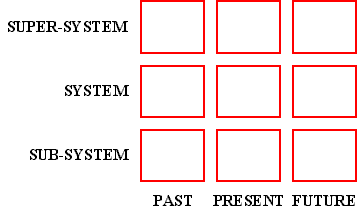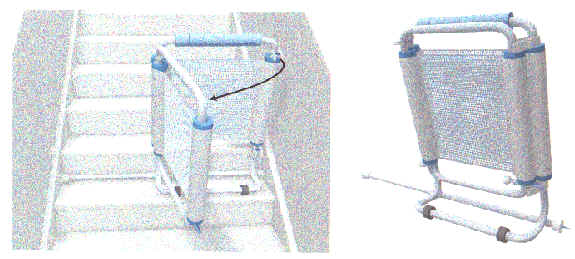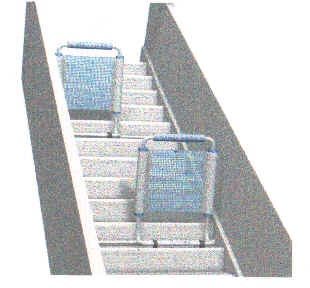
The ‘Child Safety Stairgate’ by Ann and John Hirst won the national Dyson Product Innovation Award in the UK in February 1999.
Darrell MannIntroduction
This article discusses the Child Safety Stairgate conceived by John and Ann Hirst of Team Innovation in Bath. The inspiration for the design came initially from the traumatic personal experience of watching powerless as their son fell from the top of a flight of stairs.
The fall started a search for a suitable product which would prevent a recurrence. The search proved largely fruitless.
Current safety gate variants suffer from a number of common problems. First and foremost is the way in which they are secured into position. On most stairgates, the method of securing uses highly unsatisfactory friction-based methods, and on designs where a positive fixture location is provided, the user is expected to make unsightly drillings into an appropriate piece of wall.
Other problems, then relate to lack of adaptability of the designs; for example ability to cope with different staircase widths, or the scenario, after the child has learned to open the gate, where the inconvenience of a path-blocking obstruction is no longer required, but a ‘tumble-stopper’ function - stopping children, from falling all the way down the staircase - would be a valuable feature.
This brief article examines the Team Innovation Stairgate design from a TRIZ perspective; looking at how the staircase safety problem was defined, how the design makes use of existing resources, and how, in the case of the ‘tumble-stopper’, the design successfully eliminates a physical contradiction.
Problem Definition
Effective problem definition provides the foundation upon which successful designs are built. Effective problem definition means capturing the ‘right’ set of customer requirements and translating them into parameters useable by designers.
While recognising that in many instances, customers don’t know what ‘right’ is until they’ve seen it, it would be fair to say that current stair-gate designs have done little to explore what ‘right’ ought to mean.
Current stair-gate designs are based around a relatively small number of functional requirements (FRs - see Reference 1, 2):-
Consistent with the trend identified in Reference 1, that designs generally evolve to include greater numbers of customer benefits - and hence Functional Requirements - over time, it may be expected that there is scope, relative the above list, to improve the design of the stair-gate.
A potent aid to help with the comprehensive definition of functional requirements is the TRIZ System Operator concept (Reference 3, 4, Figure 1). The concept forces designers to view the system under consideration from the perspective of a) it’s interactions with sub and super-systems, and, b) how it might be affected by time - either implications from the past, or possible implications governing future use.

Although traditionally used as a means of focusing the problem definition and problem solution processes - see Reference 4 in particular - we see here that the System Operator tool has been used in a somewhat different manner, in that rather than being used to identify a single problem, it has been used as a systematic means of identifying a whole cluster of problem definitions.
The multi problem identification concept was used in three specific instances during the conception of the new stair-gate design:-
SUPER-SYSTEM-PAST - before the stair-gate is fitted, current positive attachment systems require the drilling of location holes into the walls on either side of the stairway. A functional requirement for ‘ease of attachment’, suggests that pre-drilling operations should be eliminated if possible.
SYSTEM-FUTURE - in current designs, as soon as the infant being protected by the stair-gate becomes suitably mobile, the gate is usually removed. This despite the potential risk that youngsters will fall down stairs. Thinking about possible uses for the stair-gate system beyond it’s traditional life expectancy saw the emergence of the new ‘tumble-stopper’ function described later.
SUPER-SYSTEM-FUTURE - examination of this scenario saw the emergence of the scene in which the stair-gate is dismantled and leaves behind an unsightly mark on the wall where the fastening was positioned. This window saw the emergence of a Function Requirement ‘ease of dis-attachment’.
The full list of Functional Requirements for the new stair-gate, therefore, grew to look like:-
Use Of Resources
With a finalised list of FRs, the new stair-gate design began to emerge. Because low unit cost was recognised as a primary consideration, maximum use of available resources was then going to be a key factor if the design was to be commercially viable.
A schematic of the eventual prize winning design is illustrated in Figure 2.

Figure 2: Child Safety Stairgate
(gate held in ‘closed position by spring-loaded positive-location catch - not shown)
Important resource related issues arising during the design process, then, included:-
‘Tumble-Stopper’ Physical Contradiction
Multi-functionality was one of the key functional requirements for the stairgate stated during its conception and design phase.
In its role as a ‘tumble-stopper’, the Stairgate is required to solve a physical contradiction. The contradiction may be expressed as a need for the stairgate to both BLOCK the stairway (to prevent injury causing falls) AND to NOT BLOCK the stairway (to allow ease of passage up or down the stairway).
Physical Contradictions are solved using one of three strategies:-
Likely as not, the tumble-stopper could have employed any of the three methods.
Separation in time would have tended to imply use of some kind of moving component to solve the contradiction. This is in fact the method used to solve the problem when the gate is in ‘stair-gate’ mode - where anyone wishing to pass through the gate has to open and close the hinged gate. For the ‘tumble-stopper’ mode, however, the functional desire is for a system which seeks to minimise user intervention. In this case, ‘Separation in Space’ is often a more attractive solution option.
Inventive Principles most amenable to solution of ‘Separation in Space’ contradictions are:-
| Segmentation | Taking Out |
| Local Quality | Asymmetry |
| Nested Doll | Another Dimension |
| Intermediary | Copying |
| Flexible Shells/Thin Films |
And from these, ‘Segmentation’ and ‘Another Dimension’ were elegantly combined to produce the tumble-stopper solution illustrated in Figure 2.

Figure 2: Child Safety Stairgate in ‘Tumble-Stopper’ Position
Conclusions
References
Interested parties wishing to know more about the Team Innovation Stairgate should contact John Hirst on +44 (1225) 319949, or e-mail info@team-inno.co.uk